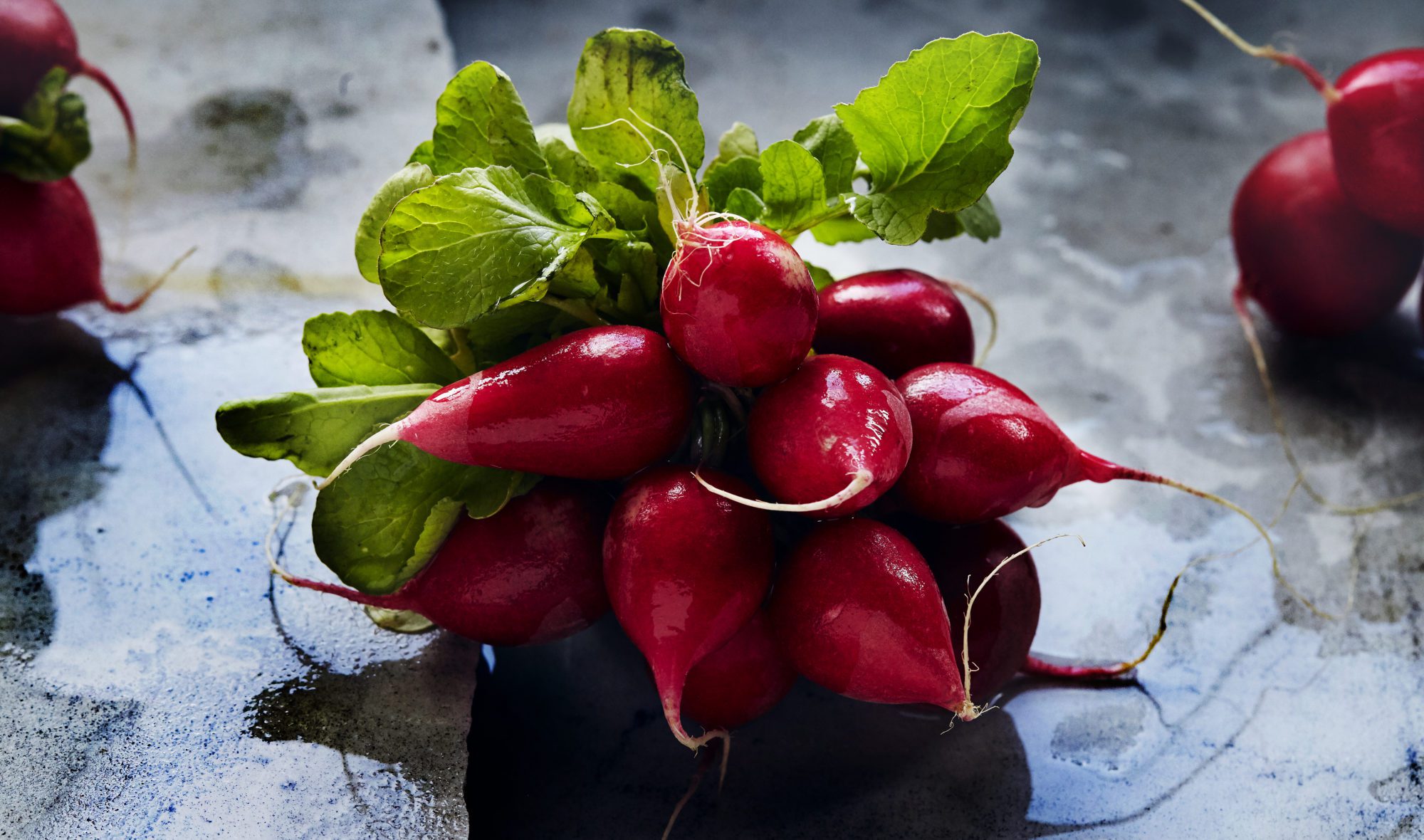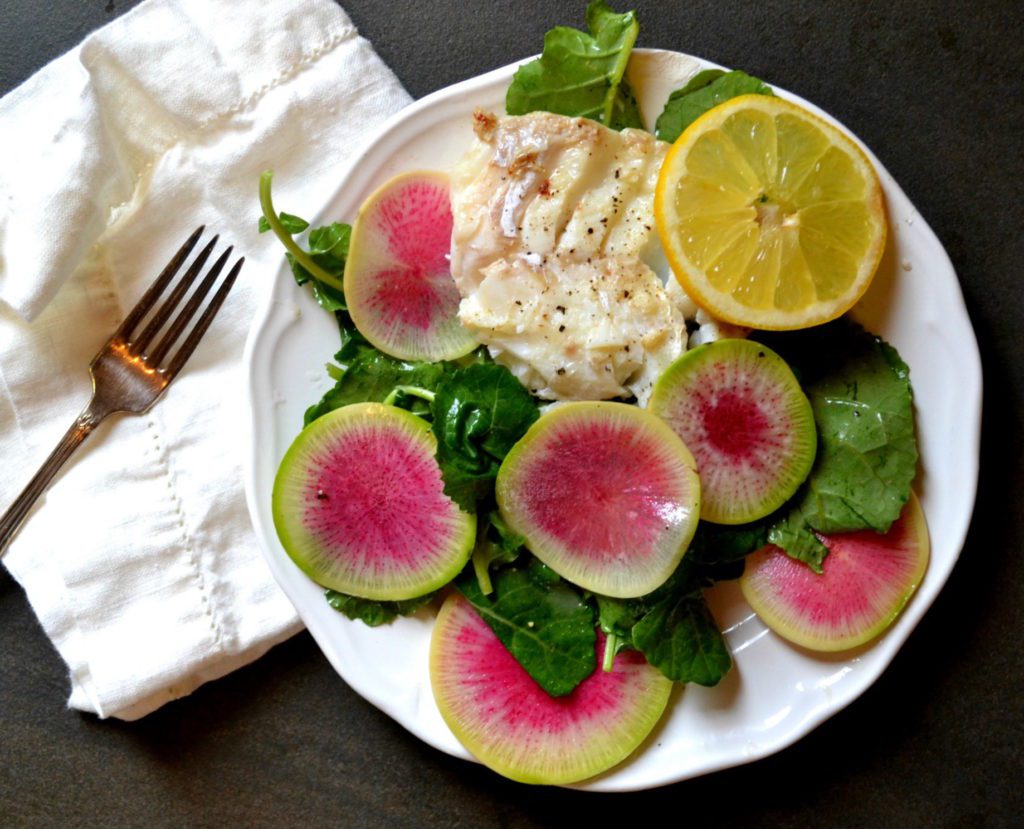
💥 SAVE 54% on the PN Nutrition Certification + Coaching Career Kickstarter Course! Ends Friday.

💥 SAVE 54% on the PN Nutrition Certification + Coaching Career Kickstarter Course!

Radishes are a crispy, spicy category of vegetables that belong to the Brassica family. There are dozens of species of radishes, and therefore their appearance ranges widely, from small and spherical to long and large in shape, and from snow white to bright scarlet to lime green in color. While all radishes possess a peppery spiciness, this too can range, from tear-inducing to pleasant and mild. Raw radishes are a good source of vitamin C, and offer a spectacular crunch.
Those beautiful little carved rosettes you see on fancy salad plates? Those are radishes! And in addition to being visually charming, they’re edible too. Radishes have style and function.
Radishes, whose name applies to dozens of subspecies, is a category of root vegetables all belonging to the Brassica family. Likely due to the sulfurous odor they emit, radishes are naturally pest-resistant and are often grown as “companion plants”, creating a protective force field for other more pest-prone plants.
Radishes are thought to have originated from Southeast Asia, although different varieties are now grown (and eaten) all over the world. However, Asians are still likely the most prolific consumers of radish, and not just for decorative purposes.
There are many types of radishes.
They can be small, starting at about one inch in diameter, or enormous, extending up to twenty inches long.
They can be mostly spherical or slightly oblong, or they can be long and cylindrical, with or without a tapered end.
While most radishes are white, some species can come in punchy colors like fuchsia, amethyst, and lime green. For example, the common North American “Cherry Belle” has bright scarlet-colored skin and snow white flesh, while the Chinese “Green Meat” variety has a bright green, white tipped exterior, and lime green interior.
All radishes are peppery and crispy, although their spiciness ranges in degrees depending on the radish in question. For example, horseradish has a spice that rises strong and fast in the sinuses and will make your eyes water in moments. However, “French Breakfast” radishes, which are squat magenta cylinders with white tips, are mild and slightly sweet.
One cup of sliced radishes (about 116g) has 19 calories, 0.8g protein, 0.1g of fat, 3.9g of carbohydrates, 1.9g fiber, and 2.2g sugar. Radishes are a good source of vitamin C.
Radishes are sold at most large grocery stores and fresh produce markets.
In order to choose a good batch of radishes, you will want to look, and feel, for a few things.
First, look at your radish contestant. If the leaves are still attached, they should look fresh and firm and green. A good radish will have smooth skin free of cracks or holes. Radishes that are relatively small in comparison to its peers are usually sweeter and less bitter.
Next, give your radish a squeeze. A good radish will feel firm and solid, not soft. Even the little root tail should be relatively firm. Bypass radishes with shriveled or wilted tails.
Radishes should be stored in the fridge in a plastic bag. If the leaves are still attached, remove them unless you will be eating the radish within the next day or so, as they can steal moisture from the radish bulb making it lose firmness and crispness.
Stored in this way, radishes can stay fresh and crunchy for three to five days.
Depending on the type of radish you choose, preparation can be minimal or may require some effort.
For most radishes with smooth skin, all that is required is a quick wash and a trimming of the tough bits (usually at the top where the leaves grow out and at the bottom where the root sprouts out). Then, radishes can be sliced into desired shapes and eaten as is.
Radishes are also delicious roasted.

This salad is a work of art with the jewel tones of watermelon radish. A warmed dressing made of mellow butter and bright lemon compliment the sharp pepperiness of radish. Mild, buttery cod is the perfect protein to make this meal complete.
Prep Time: 5 minutes Cook Time: 20 minutes Yield: 1 salad
For the Dressing:
Add all ingredients to a small saucepan and heat over low. Wisk ingredients with a fork until emulsified. Reserve for salad.
For the Salad:
Put all ingredients (with the exception of the cod) into a salad bowl. Toss well. Add dressing and toss again. Transfer to a plate. Place cooked filet of cod over the salad and eat!
Precision Nutrition’s Encyclopedia of Food expands every single month as we highlight new foods and showcase beautiful food photography. If you’d like to stay up to date, simply click this link. From there, we’ll send you a FREE copy of our recipe book. We’ll also let you know when new and delicious foods are added to the site.
Radishes are a crispy, spicy category of vegetables that belong to the Brassica family. There are dozens of species of radishes, and therefore their appearance ranges widely, from small and spherical to long and large in shape, and from snow white to bright scarlet to lime green in color. While all radishes possess a peppery spiciness, this too can range, from tear-inducing to pleasant and mild. Raw radishes are a good source of vitamin C, and offer a spectacular crunch.